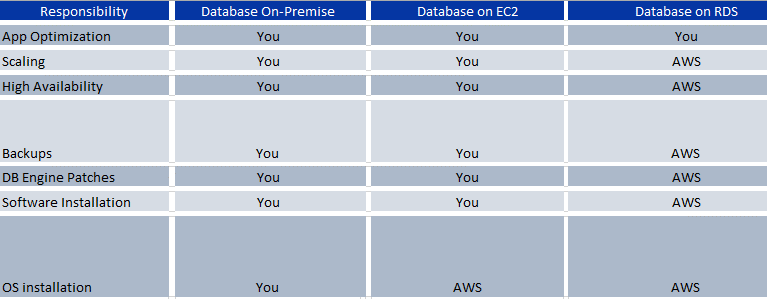EMAIL SUPPORT
dclessons@dclessons.comLOCATION
USAmazon AWS Database
Database Introduction:
A database is the engine that allow your application to manage, access, and search large volume of data in its records. Database is the backend support for every application that require large number of data to be stored or accessed.
Database engine and System can be grouped in to two categories:
Rational Database management Systems:
In this users read and write data from table from commands or queries using SQL (Structured Query language). It consists of one or more table and further contains many rows and column. A column contains specific attributes of records like name , age , number , address etc., whereas rows defines an individual records like full details of person who is employee of certain organization. Each record in a row is represented by unique ID called Primary Key, here Employee ID is primary key of each records. A record in a table can reference to another record in another table, by primary key of another record that pointer or reference is called foreign key.
A rational Data base is categorized two database systems
- Online Transaction Processing (OLTP): This refers to transaction oriented application that changes data frequently via read and write, example: e-commerce.
- Online Analytical Processing (OLAP): It is mostly used in reporting and analyzing large data sets
No SQL Database Systems:
These database systems are non-rational and don’t have same table and column like rational database systems. NoSQL database are used as key/Value store or document store with flexible schemas, A common use case for NoSQL is managing user sessions, user profiles, shopping cart data etc.
Data Warehouses:
Data warehouse is kind of repository that contain data from various resources and which is further used to compile reports , search by high complex queries by companies for their day to day work .
Amazon rational Database Service (Amazon RDS):
It is a service that provides rational database like behavior on AWS which further can launch one of many popular database engine that is ready to start taking SQL transactions. Amazon RDS can also offloads common task like backups, patching, Scaling and replication.
Amazon RDS exposes or connects database endpoints to which client software connects and execute SQL. Amazon RDS does not provide Shell access to Database DB instances and restricts access to certain tables that require advance privileges.
Amazon provides methods to query, analyze, modify, and administer databases.
Database Instances:
Amazon RDS provides an API that helps to create and manage one or more DB instances. Each DB instance is an isolated database environment that runs open source database engine like MySQL, PostgreSQL, MarinaSQL, Oracle, SQL Server, Amazon Aurora. A DB instance can be multiple different databases which can be further managed in DB instance by executing SQL commands by Amazon RDS endpoint.
Following are the API which is used to create and resize the DB.
- CreateDBInstance: API used to launch new DB instance.
- ModifyDBInstances: By using this API we can change or resize DB instance.
The range of DB instances classes extends from db.t2.micro with 1 virtual CPU and 1 Gig memory to db.r3.8xlarge with 32vCPU and 244 GB of memory.
Following table provides the operational benefits of Amazon RDS over other.

Database Engine:
Amazon RDS supports six database engines: MySQL, PostgreSQL, MaraineSQL, Oracle, SQLServer, and Amazon Aurora.





LEAVE A COMMENT
Please login here to comment.